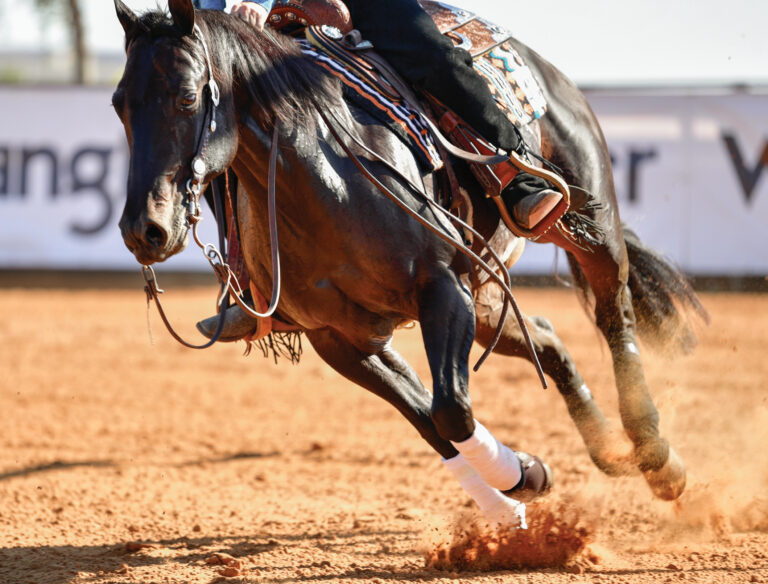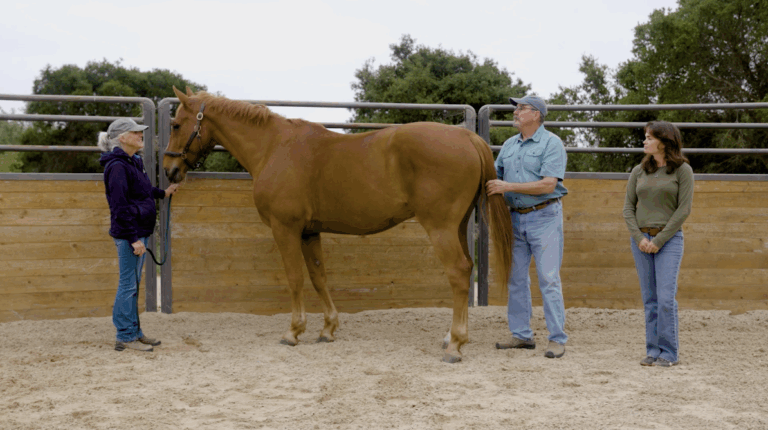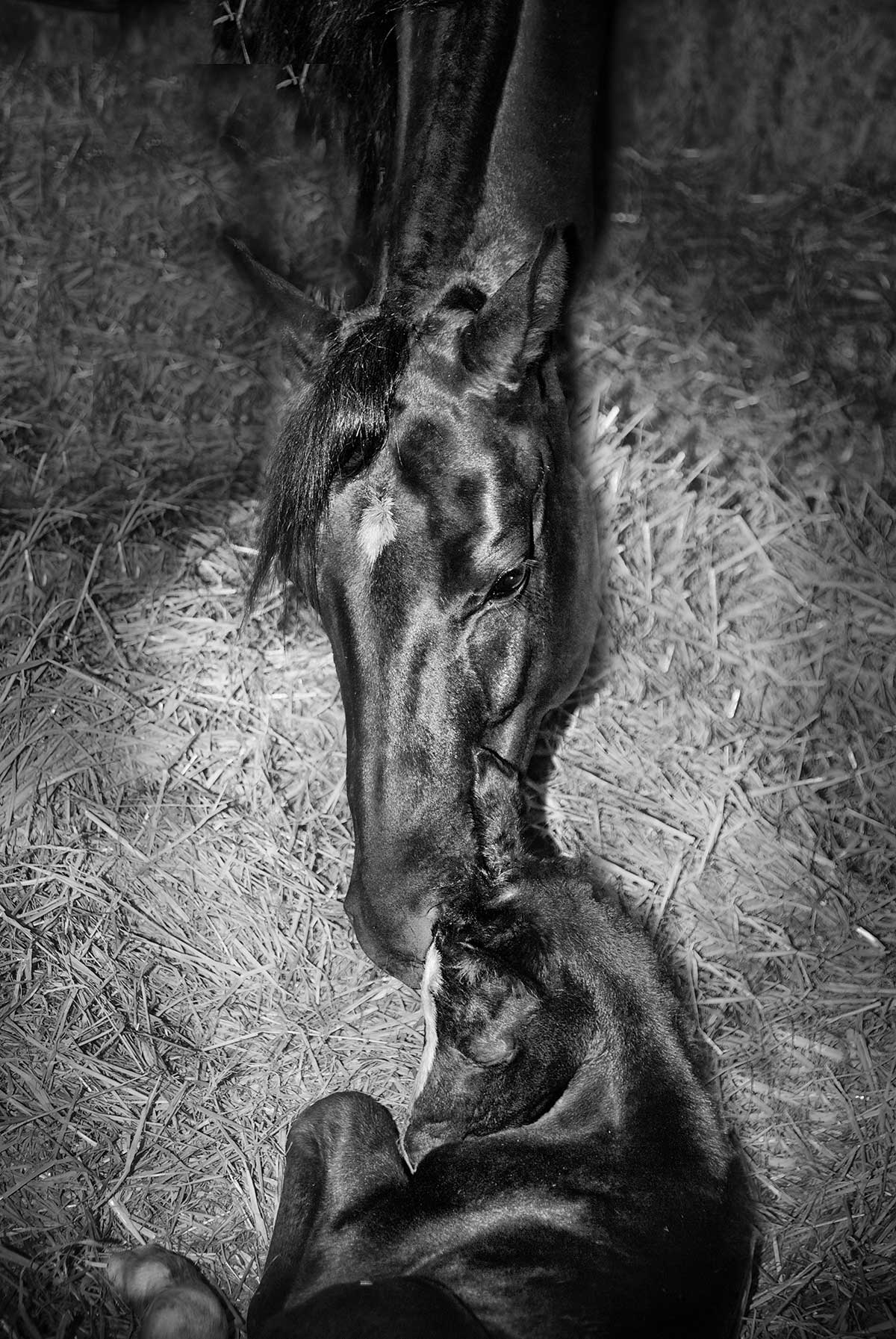
I’ve been in the barn for hundreds of foaling events and foal milestones, but I still get nervous. The mare becomes restless and uncomfortable. I work on my deep-breathing exercises. The telltale white bubble appears at the mare’s vulva. I quell the urge to run into the stall and deliver the foal myself. I see one front leg…my heart rate increases. A second front leg…I start to sweat. Finally, a nose…and I start to breathe a little easier. About 20 to 30 minutes later, when the baby’s made his entrance into the world (OK, so I usually help him out just a little bit), I breathe a great big sigh of relief.
If you’ve ever foaled out a mare yourself, you know exactly what I mean. Is it your first time? Better consider signing up for a meditation class. There’s no doubt about it: Foaling is one of the most stressful, terrifying—and wonderful—events you’ll ever experience in your horse life. And while it’s true that once the foal is born and mare and baby are resting quietly you can finally take that breath, don’t head back to the house just yet. The next 24 hours of your foal’s life are packed with critical events that may be just as important for his future as a successful foaling.
In this article, I’ll take a look at three important milestones that are crucial for your baby’s future—events you’ll need to monitor before you can rest easy.
Milestones
Immediately after birth, your most important job is to make sure the placental tissues have been cleared away from the foal’s nostrils to prevent suffocation and to dip his naval in a disinfectant to prevent infectious organisms from entering his body. Ask your veterinarian for preference about the type and concentration of disinfectant to include in your foaling kit. Then the milestones will start rolling in.
#1: He’s on His Feet!
A normal foal will rest for a short period of time immediately after birth, but should be up and on his feet within an hour. He might flop around a bit, then eventually find his footing and wobble around the stall. Within two hours of birth, he’ll be pretty stable and able to walk all by himself. If he hasn’t stood within an hour, you can offer some encouragement and assistance. Sometimes all it takes is helping him to find his footing.
Red Alert: Your foal is bright, alert, and strong. He seems perfectly normal and is making vigorous attempts to stand, but every time he tries to get up he just can’t seem to get his footing. It may seem obvious, but stall floors can become slippery when they’re wet from placental fluids expelled during the foaling process. If your foal can’t get his footing he won’t be able to stand and may become exhausted with his efforts. To prevent this, remove wet bedding immediately after foaling. When preparing your foaling stall, look for mats with a textured surface that are less likely to be slippery, and consider placing some shavings under a straw bed to give him a good surface. If you do see him slipping when he tries to stand, clean up the area and add some shavings or sawdust to provide traction.
Red Alert: Once again, your foal is bright, alert, and strong and is making vigorous attempts to stand. It just doesn’t seem like he can get his legs unfolded to stand up. If your baby’s legs are crooked or he has contracted tendons that won’t allow them to unfold, he may be unable to stand without assistance. Help him to his feet. Take care to avoid putting too much pressure on his abdomen when you help him to avoid rupturing his bladder. If he still can’t stand unassisted within two hours of birth, it’s time to call your vet. Your foal might require bandages, splints, or even casts to support his limbs. He’ll definitely need some help during his first days, or even weeks, of life.
Red Alert: Your foal is dull, depressed, and not interested in much. He’s not making much, if any, effort to stand. Call your veterinarian immediately. This baby could have a serious problem such as septicemia (an infection of his bloodstream) that’ll require intensive care to save his life.
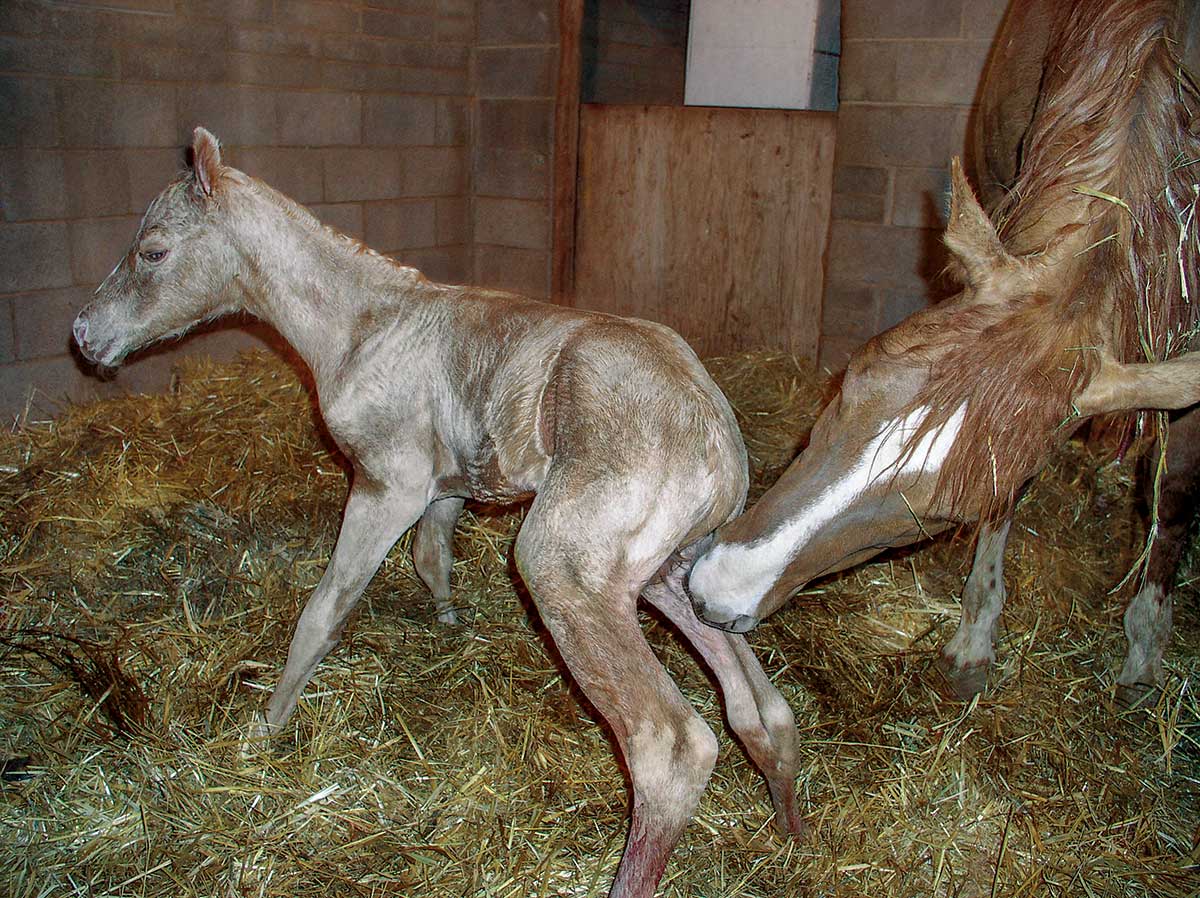
#2: Mealtime
Your normal foal is looking for the faucet as soon as he stands and will be nursing before two hours have passed. If you’ve ever tried to help a newborn foal nurse, you know how frustrating it can be. You point him toward the udder, and he frantically tries to nurse on just about any object in his path. The good news is that these vigorous efforts usually pay off, and most foals find the faucet on their own.
Your foal is born without antibodies of his own to help ward off disease; he gets those important antibodies from his mom’s first milk, called colostrum. It’s critical that your foal take his first drink before he’s six hours old, when his digestive system is still able to absorb the colostrum.
Red Alert: Your foal is up, strong, and looking for the faucet. His mom, however, isn’t so interested. A maiden (first-time) mare can be a problem if she’s too attentive and tries to follow her baby around the stall as he attempts to nurse, making it difficult for him to find the udder. In other circumstances, the mare might be protective of her private parts and try to kick or push the foal away. Even worse, some mares become outwardly aggressive toward their babies.
If you see any of this happening, try haltering your mare and holding her still while your foal attempts to nurse. In some situations, you’ll need to use a nose twitch or light sedation.If three hours have passed and your mare hasn’t settled down, call your veterninarian for advice. Heavy sedation might be necessary, and your vet might want to pay a visit to administer colostrum through a nasogastric tube before it’s too late.
Red Alert: If your foal is up but seems too weak to nurse or is too detached or disinterested to nurse, you might have a problem. He could be a “dummy foal” (see sidebar on page 66) or even have a more serious problem, such as septicemia. Offer assistance by directing him to the udder. If you’re not successful within three hours of birth it’s time to call your vet.
Red Alert: Your foal has found the udder and is nursing, but you see milk streaming from his nose when he’s finished taking a drink. This happens with some normal foals; the problem might resolve on its own during the first few days, or even weeks, of life. It can also be a sign of a cleft palate, a defect at the back of your baby’s mouth that can make swallowing difficult. If your foal is able to nurse and swallow without coughing or gagging, there’s no need to panic. Mention the problem to your veterinarian during your well-baby check. She’ll check carefully for a cleft palate. If your foal can’t swallow normally, however, it’s time to call your vet. Your foal could be at risk for aspirating (inhaling foreign particulate material), which could lead to a life-threatening pneumonia.
Bookmark This For Weaning Time
The Dummy Foal
The call came in at 2 a.m. “We have a filly, born 30 minutes ago. Everything went fine, but something doesn’t seem quite right,” my client explained. I started asking my usual questions when I heard the voice of the experienced foaling attendant in the background. “I want her to come. Now.” And I was up and on my way.
I arrived to find a beautiful bay filly standing in the stall next to her attentive mother. Her vital signs were normal; she seemed pretty strong and stable, and…sure enough, not quite right. Although she was making half-hearted attempts to nurse, she didn’t really seem to care all that much and spent most of her time wandering around, staring at the corners of the stall. Even when we directed the filly to her mother’s udder, she wasn’t really interested in nursing.
After several hours of trying to encourage the filly to nurse, I knew something had to be done. We were dealing with a “dummy foal.”
We collected some colostrum and administered it to the filly via nasogastric tube to be sure she’d get those crucial antibodies in time, then set about making a plan.
Between three and five percent of foals are affected with neonatal maladjustment syndrome, and are referred to as “dummy foals.” This condition has historically been attributed to oxygen deprivation during the birth process, but recent research has pointed toward a different cause—abnormal levels of substances known as neurosteroids. When a foal is born, he makes a transition from calm to conscious. He’s in a semi-tranquilized state in utero (necessary to protect the mare), yet within minutes of birth he becomes bright, alert, and ready to take on the world. This transition is believed to be due to an adjustment of neurosteroids that occurs because of pressure experienced as he passes through the birth canal during the birthing process. This theory is supported by the fact that neonatal maladjustment syndrome is more common in foals born via cesarean section or those with unusually rapid births. Although 80 percent or more of these foals do survive and grow up to be normal, it’s often after weeks of intensive nursing care.
I pitched the idea of trying the Madigan Squeeze to the filly’s owner. I’d just heard about this technique at a recent meeting of the American Association of Equine Practitioners, and it seemed worth a try. Developed by John Madigan, DVM, MS, at the University of California, Davis, the technique had been getting a lot of attention. Dr. Madigan proposed carefully applying pressure with a rope around the foal’s body to mimic the “squeeze” a foal would normally experience during birth in an attempt to regulate the neurosteroids. It was simple and inexpensive—and Dr. Madigan had reported amazing success.
After unraveling the thick, cotton castration rope that I carry in the back of my truck, we set about learning how to tie a bowline knot. After 30 minutes of trial and error, we finally managed to perfect the technique of wrapping each other up in ropes and “snugging down” enough to create pressure.
We successfully snared the filly with our rope, cinched down on our bowline knot, and dropped her to the ground. “This is never going to work,” I thought, as we watched Dr. Madigan’s video clips playing in the background, depicting dummy foals jumping up to nurse the minute the rope was removed after a mere 20 minutes.
Our 20 minutes were soon over, and it was time to see what happened. Just like clockwork: We removed the rope, the filly stood up, she walked over to her mother, and had her first real drink. “Well that’s pretty amazing,” I thought. But I still figured I’d be spending most of my day at the farm. I went home for a much-needed shower, told my client to keep a close eye on the filly, and promised to be back in a couple of hours to tube the filly again.
I returned to find a completely normal filly—nursing regularly and bouncing around the stall. She never looked back. I immediately bought three appropriate lengths of soft cotton rope for each of my associate veterinarians’ trucks and scheduled a bowline-knot-tying education session for my staff. It was obvious to me: The Madigan Squeeze technique is a tool that should be a part of every foaling kit.
I arrived to find a beautiful bay filly standing in the stall next to her attentive mother. Her vital signs were normal; she seemed pretty strong and stable, and…sure enough, not quite right. Although she was making half-hearted attempts to nurse, she didn’t really seem to care all that much and spent most of her time wandering around, staring at the corners of the stall. Even when we directed the filly to her mother’s udder, she wasn’t really interested in nursing.
After several hours of trying to encourage the filly to nurse, I knew something had to be done. We were dealing with a “dummy foal.”
We collected some colostrum and administered it to the filly via nasogastric tube to be sure she’d get those crucial antibodies in time, then set about making a plan.
Between three and five percent of foals are affected with neonatal maladjustment syndrome, and are referred to as “dummy foals.” This condition has historically been attributed to oxygen deprivation during the birth process, but recent research has pointed toward a different cause—abnormal levels of substances known as neurosteroids. When a foal is born, he makes a transition from calm to conscious. He’s in a semi-tranquilized state in utero (necessary to protect the mare), yet within minutes of birth he becomes bright, alert, and ready to take on the world. This transition is believed to be due to an adjustment of neurosteroids that occurs because of pressure experienced as he passes through the birth canal during the birthing process. This theory is supported by the fact that neonatal maladjustment syndrome is more common in foals born via cesarean section or those with unusually rapid births. Although 80 percent or more of these foals do survive and grow up to be normal, it’s often after weeks of intensive nursing care.
I pitched the idea of trying the Madigan Squeeze to the filly’s owner. I’d just heard about this technique at a recent meeting of the American Association of Equine Practitioners, and it seemed worth a try. Developed by John Madigan, DVM, MS, at the University of California, Davis, the technique had been getting a lot of attention. Dr. Madigan proposed carefully applying pressure with a rope around the foal’s body to mimic the “squeeze” a foal would normally experience during birth in an attempt to regulate the neurosteroids. It was simple and inexpensive—and Dr. Madigan had reported amazing success.
After unraveling the thick, cotton castration rope that I carry in the back of my truck, we set about learning how to tie a bowline knot. After 30 minutes of trial and error, we finally managed to perfect the technique of wrapping each other up in ropes and “snugging down” enough to create pressure.
We successfully snared the filly with our rope, cinched down on our bowline knot, and dropped her to the ground. “This is never going to work,” I thought, as we watched Dr. Madigan’s video clips playing in the background, depicting dummy foals jumping up to nurse the minute the rope was removed after a mere 20 minutes.
Our 20 minutes were soon over, and it was time to see what happened. Just like clockwork: We removed the rope, the filly stood up, she walked over to her mother, and had her first real drink. “Well that’s pretty amazing,” I thought. But I still figured I’d be spending most of my day at the farm. I went home for a much-needed shower, told my client to keep a close eye on the filly, and promised to be back in a couple of hours to tube the filly again.
I returned to find a completely normal filly—nursing regularly and bouncing around the stall. She never looked back. I immediately bought three appropriate lengths of soft cotton rope for each of my associate veterinarians’ trucks and scheduled a bowline-knot-tying education session for my staff. It was obvious to me: The Madigan Squeeze technique is a tool that should be a part of every foaling kit.
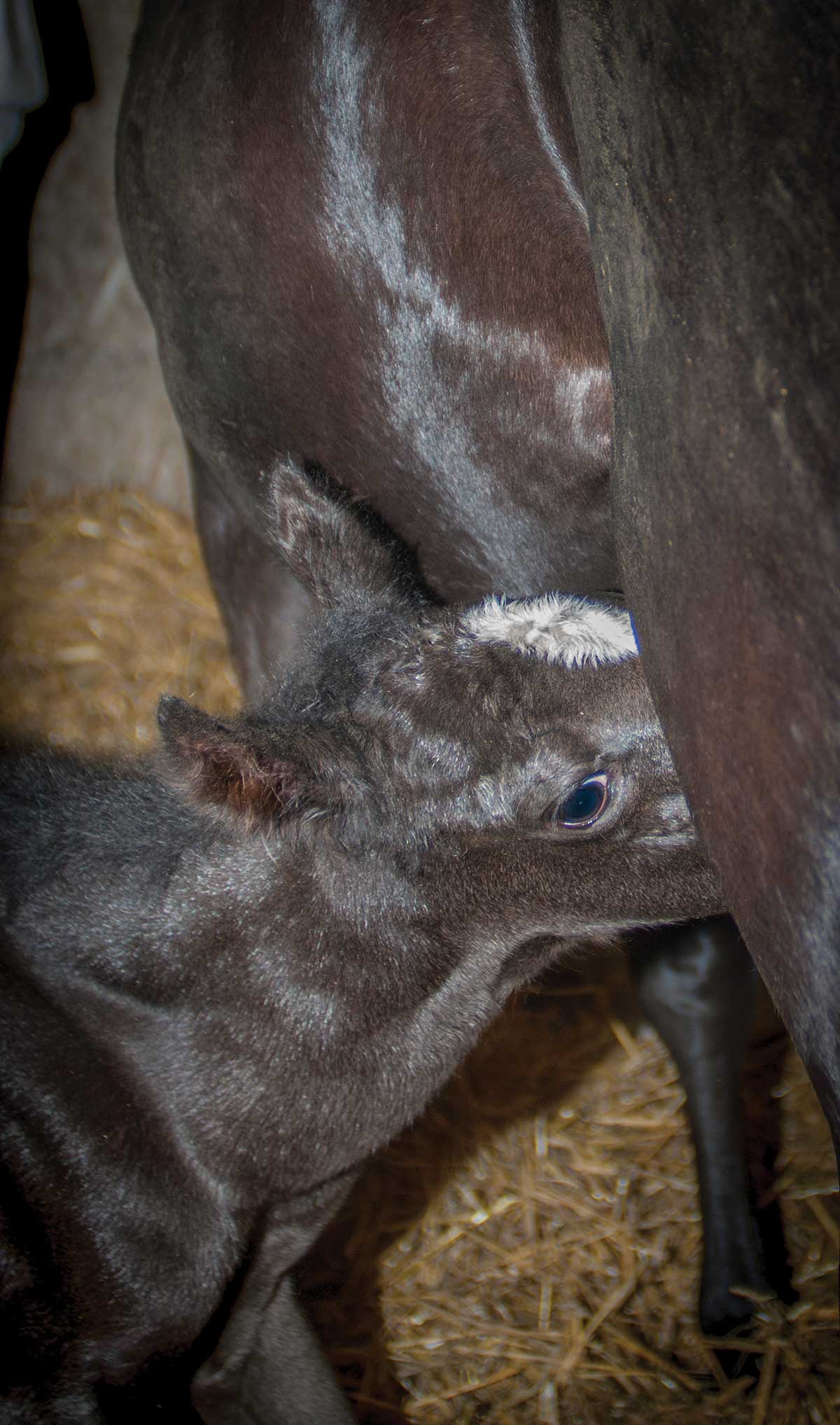
#3: Plumbing Check
Your normal foal will usually begin passing meconium, his first manure, soon after he first nurses because nursing stimulates the gastrointestinal tract to move. Typically, you’ll see the tarry, black meconium within three to four hours of birth. It takes a little longer for your foal to urinate—usually six to twelve hours. That might be a first event you’ll never see.
Red Alert: If your foal doesn’t pass meconium promptly, he might start straining. He’ll stand stretched out with his tail raised, and you can see his abdomen contracting. When you see this happening, you can administer an enema, which may be all it takes to help him get things moving. Enemas can be repeated several times, but if that’s unsuccessful your foal is likely to become more and more uncomfortable. Eventually, he’ll exhibit full-blown colic symptoms, thrashing and rolling around the stall. In most cases, your vet can address a meconium impaction at the time of your well-baby check, but if your foal begins to look uncomfortable before that happens, it’s time to call your vet.
Red Alert: You see your foal urinate and notice urine coming from his umbilicus. Your baby could have a patent urachus, a condition where the urachus (structure that allows your foal to eliminate fluids while in utero) doesn’t seal off properly at birth. A patent urachus can be a sign of a more serious underlying problem such as an infected umbilical cord, or even septicemia. To help prevent this, it’s critical to dip your baby’s naval in a disinfectant immediately after birth. If you see it happening anyway, it’s definitely time to call your vet. A patent urachus may resolve with careful disinfection and antibiotics, but it can also be a serious problem that will require surgery to correct.
The Well-Baby Check
You’ve survived the foaling event; your baby is up, nursing, and has passed his meconium. Good work! Now it’s time to call your veterinarian for a “well-baby” check. If all seems normal, your vet will typically want to see your foal between 18 and 24 hours of birth (that’s how long it takes for antibodies to be completely absorbed from the colostrum). She’ll examine your mare for signs of birth trauma, check her udder to ensure that she’s producing adequate milk, and will take a look at the placenta to be sure it was completely passed. Your vet will then perform a complete physical examination of your foal, including checking his eyes, mouth, heart, lungs, and legs. She’ll carefully examine his umbilical cord and, in some parts of the country, administer a vitamin E and selenium injection. Perhaps most importantly, she’ll draw a small sample of your foal’s blood to test for antibodies to ensure that he ingested adequate colostrum when he first nursed.
Has your vet checked off all the boxes on the well-baby check? Congratulations! You’ve survived a successful foaling event and are ready for the next phase of your new baby’s life.

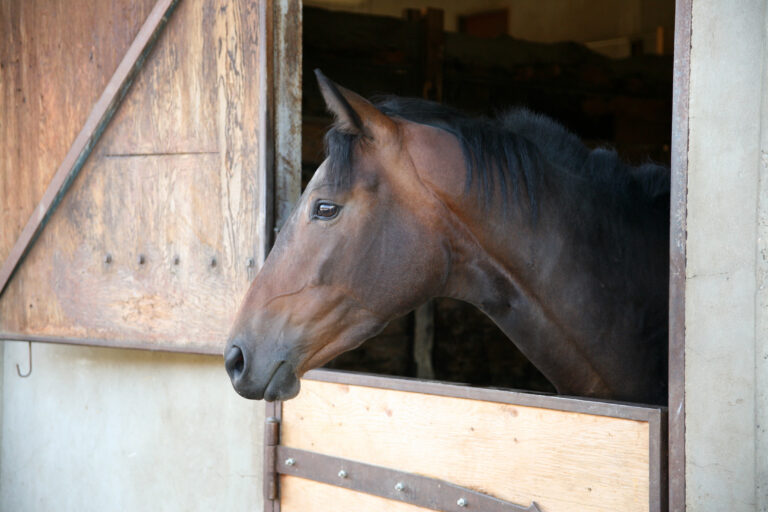
![[Aggregator] Downloaded image for imported item #35942](https://s3.amazonaws.com/wp-s3-horseandrider.com/wp-content/uploads/2025/10/20105738/EDCC-Unbranded-14-300x200-1.jpeg)
